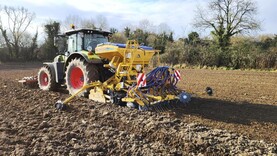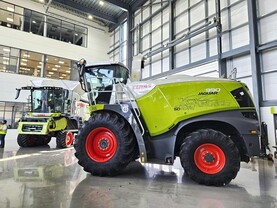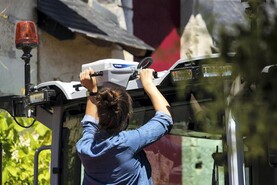Based in Killucan, Co Westmeath, Paul Scally and his son Sean are the men behind the Claas act that is Scally Silage.
Aside from agricultural contracting, Paul owns RKC, a steel fabrication and groundworks company. Any day of the year, RKC could have up to 15 diggers working on sites across the Dublin/Kildare region.
In 2009, Paul began changing his approach and bought his first new tractor, a Claas tractor. Today, the silage fleet comprises 15 Claas tractors alongside two Claas forage harvesters, two twin-rotor rakes and two sets of Claas butterfly mowers. A JCB 419S and a JCB 418S along with a number of 22ft Broughan trailers make up the remainder of the silage fleet.
Background
During the 1970s, Paul served his time as a mechanic with local machinery dealer, Lyons and Burton. Alongside carrying out nixers in his spare time, he and his brother bought a secondhand New Holland 339 double chop harvester in need of some repair.
From here, the contracting journey began. Once repaired, it was hooked to their father’s Zetor 8111 and the lads started cutting for neighbours. After several JF 900s and Tarrup Ten Xs, as the business grew and grew Paul made the leap in 2004 to a 2000 Claas Jaguar 860 self-propelled forager.
Having always had an interest in steel fabrication carrying out repair jobs for a number of years, it quickly grew into a business of its own. Paul used this as an opportunity to diversify and retain full-time staff.
Having been in around sites as a result, he took up an opportunity to branch out further and carry out ground works operations. Today, fifteen diggers are kept busy all year round. Each of the enterprises has grown to complement each other from a staffing and machinery point of view. Contracting is now the smaller operation given that it’s seasonal.
However, Paul will tell you himself that agricultural contracting is where his heart lies.
“As busy and as stressful as it does be at times, sitting up on a machine is like therapy to me,” he laughed.
Turning point
“Up until the first Claas which I bought new, I would have operated a policy of buying all secondhand machines and not being afraid of repairs. We would often come home from a day’s work to take into repairs in the workshop for the next day! I always would have prided myself for running an older fleet although doing the same amount of work as other contractors. However, between night time repairs and what not it was taking me longer,” Paul said.
The time lost on repairs and the unpredictable maintenance costs led Paul to bring about change. The current policy is to keep tractors changed frequently for new or ex-hire machines. The larger 800 series Axions tend to be changed more frequently while some of the Arion 600s will stay on longer and work away on sites. “With the current prices and availability of parts and labour, the benefits of warranty are critical. Farmers to a degree feel reassured seeing modern machinery do their work.
Why Claas?
“My first experience with Claas tractors was in 2006. I had a John Deere 6920 at the time which was originally bought to pull a low loader but there were many times the low loader transported the tractor rather than the other way around.
Leinster Farm Machinery gave me the loan of a new Claas Ares 656 RZ, pretty much green Renault at the time. The guys I had working it didn’t want to give it back. They loved it for power and comfort,” Paul said.
In 2009, he tried out a new Claas Arion which he then bought. From there, the fleet gradually transitioned to consist solely of new Claas tractors.
“I’ve always considered a Claas tractor to be a good concoction of brands. John Deere and FPT engines coupled with an AGCO backend – all proven manufacturers.”
When Claas updated its 600 series tractors from what was formally Renault’s design, he said it was a major step in the right direction. In 2016, the first Axion 800 series tractor was bought to run butterfly mowers. At this point, an Arion 650 formed the other half of the mowing fleet with a front- and side-mounted setup. Now, Paul operates two butterfly combinations.
Today, the fleet comprises six Axion 800 series tractors: 810 x2, 830, 850 x2, and an 870, all of which are fitted with the Cmatic CVT transmission aside from the 830. There are also nine Arion 600 models: 630, 640 x2, 650 x 6 the oldest being the 2013 630.
Aside from mowing, one of the main reasons for the larger chassis is its added weight for low loader work moving diggers from site to site as well as pulling 20t dumpers.
The Westmeath man is now a firm believer in keeping consistency within the fleet when it comes to brands.
“Sticking with the one brand streamlines everything from buying to selling to servicing. For example, the majority of tractor parts and filters are the same across all the 600 or 800 models. if I ever need anything, one phone call to Leinster Farm Machinery is all that’s needed whether it’s in relation to tractors, grass or tillage equipment or trailers.” Paul feels that a symbiotic relationship with a dealer is important.
“We’re lucky to have excellent staff. All the lads are fond of the Claas tractors. With that many features on modern tractors it’s important that operators are happy and know the ins and outs of them and what they’re capable of. Keeping one brand makes this easier.”
Axion 850 and 870
Last year, Paul upgraded his mowing outfit alongside a new Jaguar 870 forager. He bought a new Axion 870 Cmatic along with a set of Disco 9200 C AS grouper mowers. An Axion 850 drives the smaller Disco 8500C butterfly mowers. The reason for the groupers is that there are often times during a challenging season when the rake follows the mowers. The groupers eliminate this.
Both the Axion 850 and 870, like the other 800 series tractors, are powered by a 6.7l FPT engine. The 850 produces a maximum 264hp (1,132Nm) while the 870 is tuned to produce 295hp (1,276Nm), 31hp mower.
Paul and the team are fond of the Cmatic CVT transmission, especially for mowing, so speed can constantly be adjusted to suit the crop. Claas build their own Cmatic transmission in-house.
There are three operating modes – accelerator pedal, drive lever and manual. In the first two modes, the forward speed of the tractor can be altered by either the accelerator pedal or the drive lever. The engine speed and transmission ratio will then automatically adjust itself for maximum performance. In manual mode, the operator selects engine speed and the transmission ratio.
“The 850 is a real good going tractor For a while I thought the 870 was a little under-powered but it turned out that there was a problem with an AdBlue sensor causing the tractor to derate.
“That said, the 9200 C AS aren’t just wider mowers, they have a permanent belly plate to the back of the conditioner to guide the grass on to the belt. You can even see the positive effect it has at conditioning grass given that it’s held for longer. This would leave the mowers that bit harder to drive too.”
Control layout and comfort are two major selling points to the Claas tractors, according to Paul.
“I don’t believe that there is any other tractor out there that’s as comfortable aside from a Fastrac. Visibility too cannot be faulted.”
Paul did note that he would like to see an improvement in the paintwork. He said that after six months you can notice the shine leaving the green colour as it begins to fade.
“It seems to only be an issue with the tractors. The paintwork on the harvesters seems much better.”
Best Claas, Worst Claas
Now cutting silage for 36 years, Paul said that hands down, the best tractor he has owned to date was an Axion 810. After 8,000 hours, aside from typical maintenance, a handbrake cable was the only issue with the tractor. Everything from power to comfort to fuel consumption was faultless.
“The largest job we’ve had to do with any of the Claases were the clutch packs on a 600 series. In the tractor’s defence, driver error had a role to play– reversing in too high of gear was partly to blame.”
“I had an Arion 660 for a season. It didn’t suit us at all. The power boost didn’t engage at the right time and there seemed to be nothing that could be done. I traded it back in for another Arion 650 Hexashift.
“In hindsight, we had no real use for anything with more power than a 650 of that chassis size. The 650s are plenty capable of pulling 22ft Broughan trailers. It’s the larger chassis of the 800 series that suits better for haulage work, not the extra power with the exception of mowing. The 660 is the ideal power to weight for the majority of tillage farmers.
“Claas are by no means a faultless machine. But any issues we’ve had have not been major. Resale values have also been strong which is important. Based on the product and the service, I don’t envisage us moving away from the brand anytime soon whether that be with tractors or grass equipment,” Paul said.






 This is a subscriber-only article
This is a subscriber-only article


















SHARING OPTIONS: